There are reptile keepers that want to get the biggest and baddest herps that are out there. There is something about owning large monitors, constrictors, or crocodilians that makes keeping these reptiles exhilarating. These animals command your attention. I should know; I used to be one of those keepers.
However, I have to admit that I have also kept some of the smallest of the reptile species. They have given me as much enjoyment as the larger species.
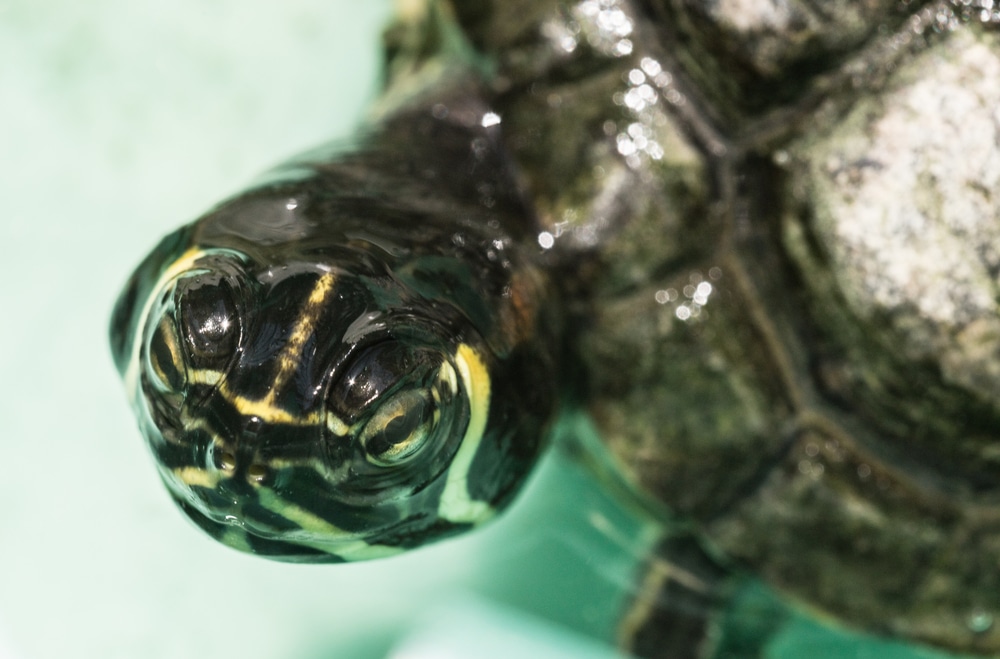
One of my favorites of the smaller reptiles was among the turtle species. These turtles make wonderful and entertaining pets. Some of them have loads of personality, are comical, and are simply darn cute.
What is also great about these small turtle species is that they are easy to keep compared to their behemoth relatives. So, in celebration of these petite chelonians, we present you with some of our favorite pint-size turtle species:
Note: The Bog turtle and spotted turtle is not listed here as it is classified as a threatened or endangered species. It is highly recommended you check your state’s laws before purchasing a turtle. Many laws regulating turtles vary from state to state.
Quick Navigation
Types of Turtles that Stay Small
Here are a few of our favorite turtle species that stay small enough to keep as pets.
Mississippi Mud Turtle (Kinosternon subrubrum)
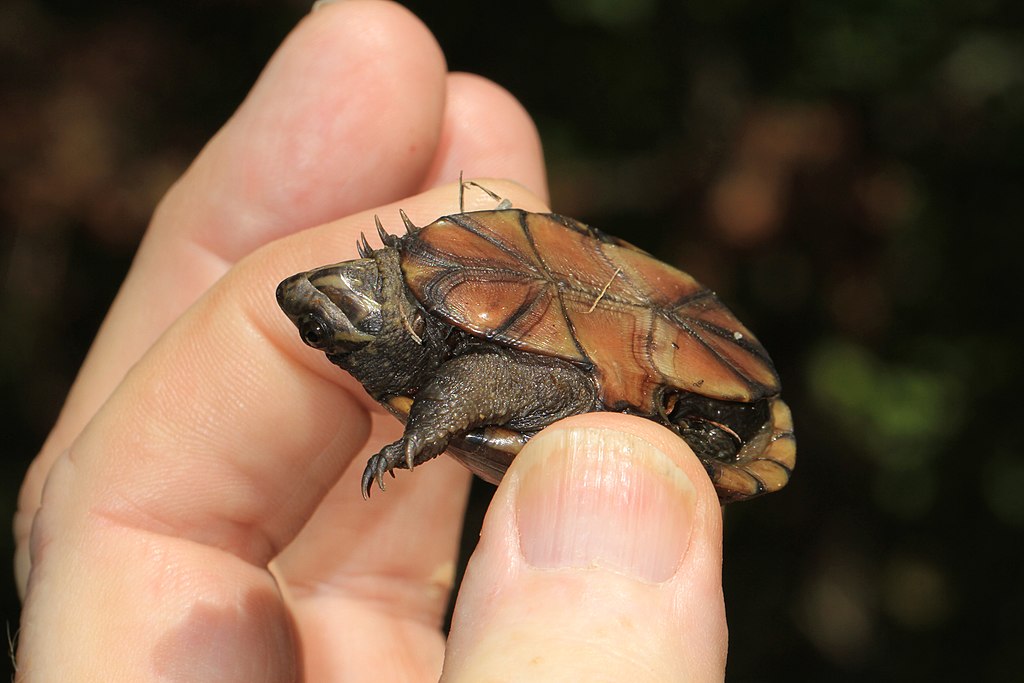
Though small in size, mud turtles should not be kept by small children. They do not have the friendliest of personalities, and they have a sharp beak.
- Size: The Mississippi mud turtle is among the smallest of North American turtles. At birth, they are only an inch long. Adults range from 3.5-4 inches in length.
- Geographical range: From the Lower Mississippi River Valley to parts of Kentucky and Texas.
- Coloration: Ranges from black to brown. Yellow stripes often will appear on their side of their head.
- Unusual fact: Mississippi Mud turtles do not spend much time basking; however, they like to roam on land. Remember this when setting up their enclosure.
Enclosure:
A good turtle for the beginner reptile keeper, the Mississippi mud turtles, is best kept in a 20-gallon aquarium or larger. A good rule to go by is to provide 6 square inches per 1-inch length of turtle (going by the length of the carapace). It is highly recommended that you use an external filter to keep the water clean. These turtles easily foul their water through elimination and while feeding.
The water temperature should be kept between 74- 84 degrees Fahrenheit. A basking place needs to be provided, and it should be kept at between 85 – 92 degrees Fahrenheit. Heat lamps and aquarium heaters can be used to maintain these temperatures. Though aquatic, Mississippi mud turtles do enjoy spending time on land. If you can, set up the aquarium, so part of it is land-based. UVB bulbs will be needed to ensure proper shell and bone development.
Feeding:
In the wild, Mississippi mud turtles are largely carnivorous, eating insects, crustaceans, and freshwater mussels. They do sometimes eat plant matter. Captive specimens do well on worms, feeder fish, and insets. Pieces of meat, fish, and chicken can also be given. Still, they should not make up their diet’s totality as these food items lack the sustenance they would get from eating whole organisms.
There are also commercial diets for aquatic turtles that available. It is important to get quality and reputable brands like ReptoMin or Mazuri. Also, many aquatic turtles like Croc Chow. However, you also need to supplement their diet with green leafy vegetables such as dandelion, parsley, and lettuce. Dust acalcium supplement powder on the food at least once a week
Common Musk Turtle (Sternotherus odoratus)
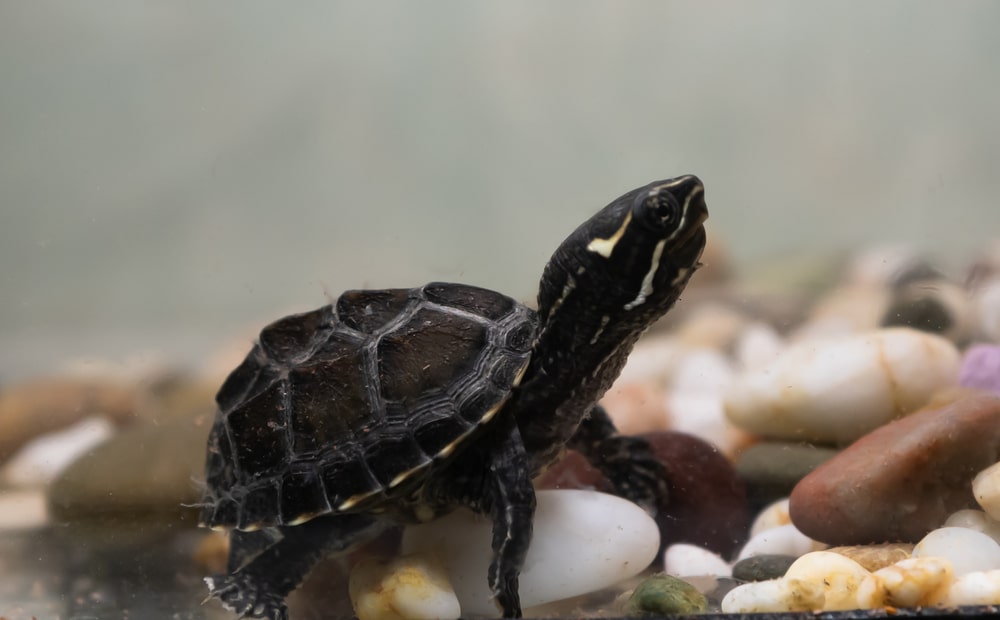
When frightened, the common musk turtle will release a foul-smelling odor from a pair of glands located near its plastron’s base (the lower half of the shell). It is no wonder why they are also known as “stinkpots.” This behavior will usually cease after your turtle gets to know you.
- Size: 2.5-4.5 inches. Females tend to be smaller than males. Hatchlings are the smallest of all North American turtles.
- Geographical range: Most of eastern North America
- Unusual Fact: Common musk turtles are good climbers and have been known to climb trees (worth remembering when setting up their enclosures).
Enclosure:
An adult musk turtle will do well in a 20-gallon aquarium or larger. Male musk turtles can be aggressive toward each other if kept together. Also, male musk turtles can be aggressive toward females during parts of the year. If you keep more than one musk turtle together, pay attention to the dynamics between them. A shallow-water species, musk turtles, should not be kept in deep water. A water depth of 18 inches is more than enough.
Though musk turtles do not frequently bask, it is still important to provide them with a basking place. Provide them with a heat lamp and UVB light. The basking area’s temperature should be around 90 degrees Fahrenheit, while the water temperature should be between 72 and 78 degrees Fahrenheit. Substrate for the aquarium is not needed.
Feeding:
In their natural habitat, musk turtles are largely carnivorous, feeding on insects, crustaceans, worms. However, they also can be scavengers, feeding on the bodies of dead fish and other animals. In captivity, mud turtles do well on a good commercial reptile diet like croc chow, pieces of raw meat or fish, worms, and chopped shrimp. Crickets and other insects can also be given.
Reeves Turtle (Mauremys reevesii)
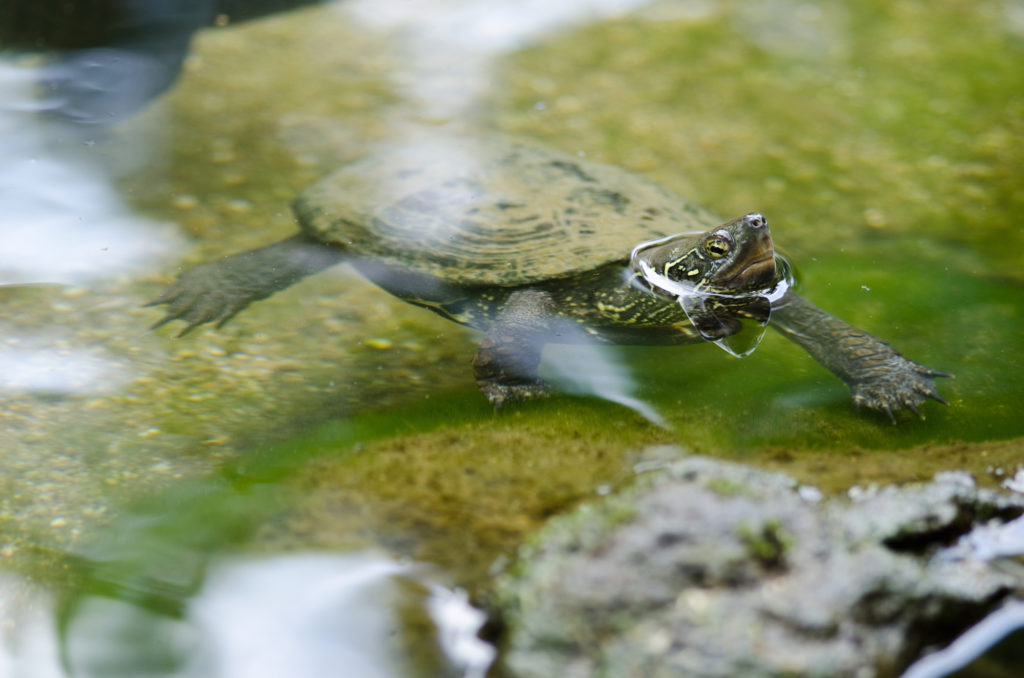
With their charming personalities and small size, Reeves turtles are a highly desirable species for those who have previous reptile-keeping experience.
- Size: Reeves turtles can obtain a length of 9 inches; however, they generally do not attain this length. The average size is 6 inches, with females being larger than males.
- Geographical range: Asia, China, Taiwan, and Japan. They also can be found in North and South Korea.
- Coloration: Reeves turtles have a dark-colored shell and skin. The color can be black or tan colored. They also have yellow stripes on their heads and necks.
- Unusual fact: Though Reeves turtles are aquatic, they are not good swimmers. Keep this in mind when you set up their enclosure. Also, they can live up to 25 years in captivity.
Enclosure:
In their natural habitat, Reeves turtles are fond of shallow water bodies with sandy bottoms, ample aquatic plants, and an abundance of basking areas. When setting up their enclosure, all these things should be considered.
The enclosure requirements for Reeves turtles will be more demanding than mud turtles as these are active reptiles. A single Reeves turtle will do okay in a 50-gallon aquarium. If additional individuals are kept together, it is recommended that you increase the aquarium capacity by 15 gallons for each additional turtle. Baby Reeves turtles can start off in a 15-gallon aquarium. It is important to note that Reeves turtles can be territorial, so use caution when keeping them in a group setting.
Reeves turtles are not good swimmers, so the water’s depth should be about one and a half times the length of your turtle’s shell. The water temperature should be kept between 70-80 degrees Fahrenheit. A basking spot is necessary, and the enclosure should have a heat light over the basking area and a UVB light. The basking area should be kept at 85-95 degrees Fahrenheit.
Keeping their water clean is important, so an effective filtration system is necessary. External filters, such as canister filters, are recommended. Also, offer your turtle a place to hide. You can create a hiding spot using live or artificial plants or rocks. Reeves turtles can be kept in an outside pond. Check that their enclosure is equipped with protection from predators, is escape-proof, and you can meet the temperature requirements.
Feeding:
Reeves turtles are omnivorous, though the larger portion of their diet will be meat. Offer a good commercial turtle diet supplemented with worms, chopped fish, snails, and insects. When it comes to using snails or insects, use caution to avoid using snails from the backyard as they may harbor pesticide residue. Preferably, purchase these feeder items from a reputable dealer. Also, offer plant-based food like green leafy vegetables. When using commercial turtle food, the diet’s recommended composition should contain 30%-40 protein, be low in fat, Vitamin D, and a Calcium to phosphate ratio of at least 2:1. It should also be supplemented with minerals and vitamins.
Diamondback Terrapins (Malaclemys terrapin)
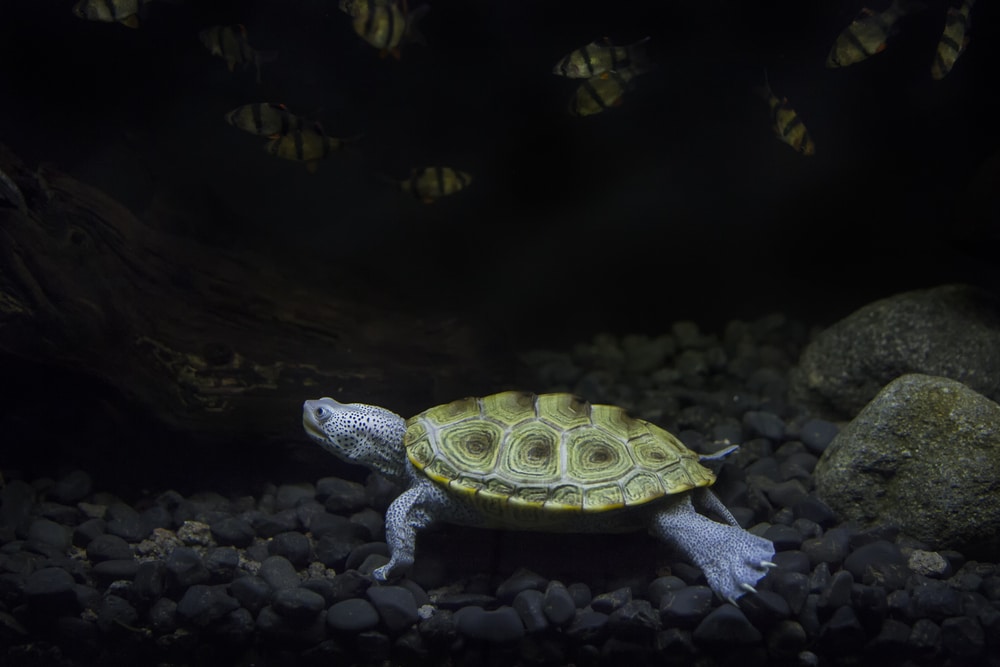
An attractive species, the diamondback terrapin is good-natured and gets along well with its own kind. Unlike most American turtles, diamondbacks live in brackish waters. For this reason, they are not recommended for the beginning turtle keeper.
- Size: Diamondback terrapins can range from 5-9 inches, with females larger than males.
- Geographical range: Eastern and Southeastern coastal areas in the United States with some populations focused around west Texas and southern Florida. They inhabit brackish waters.
- Coloration: This species has a unique appearance with its shell that can be dark or light in color and yellow and orange tint. The skin color is usually light gray or even white and is spotted black. Their jaws are often white.
- Unusual fact: The diamondback terrapin’s conservation status varies from state to state. In Long Island, it is considered endangered, while in Massachusetts, it is considered threatened. It is important to check your state’s laws.
Note: This species is not recommended for beginner reptile keepers. They require extra attention due to their husbandry needs as they are prone to shell diseases and some other fungal problems.
Enclosure:
Diamondback terrapins are an active species, so a larger enclosure is needed. A 70-gallon tank would be adequate for one or two turtles. Water quality is critical for this species’ health, so the tank must have a powerful filtration system. Exterior filters like those hanging on the aquarium’s back are good choices, but canister filters are even better.
A basking place needs to be offered, and it should be under a heat and UVB lamp. The water temperature should be kept between 76-78 degrees Fahrenheit, while the basking area should be kept between 80-90 degrees Fahrenheit. Remember, diamondback terrapins are a brackish water species, meaning that they naturally inhabit water bodies where the ocean and freshwater meet. For this reason, it is essential to their health that you provide them with similar conditions. Add enough salt to keep the salinity level of the water at a 1.014 buoyancy ratio. This can be measured by purchasing a hydrometer. They are inexpensive and can be found at aquarium shops that sell saltwater fish.
The proper salt content is needed to prevent them from developing fungus infections of their skin and shell rot. It is important to note that as water evaporates, its salinity will increase. For this reason, it is important to keep the water level constant and check the salinity daily. If your diamondback terrapin is captive bred, it may not require brackish water. You can check this out by contacting the breeder.
Feeding:
The feeding of diamondback terrapins should be varied and include shellfish, shrimp, commercial diet, chopped-up fish, worms, and snails. Unlike many other turtles, it is recommended that you avoid feeding your diamondback chicken or beef. As these items are not encountered in their natural habitat, your turtle may have trouble digesting these food items.
Box Turtles

The North American, there are four main subspecies of box turtles. They are:
- Eastern Box Turtle(Terrapene carolina carolina)
- Three-Toed Box Turtle(Terrapene carolina triunguis)
- Gulf Coast Box Turtle(Terrapene carolina major)
- Ornate Box Turtle(Terrapene ornata ornata)
These are the subspecies that you most likely will have as a pet. The size and husbandry care that follows is appropriate for these subspecies.
- Size: The average size of a box turtle is 6 inches.
- Geographical range: Depends on the subspecies.
- Appearance: All the box turtle subspecies have the same general appearance. They have a high domed shell, and they lack webbed feet. Also, their plastron (the bottom half o the shell) has a hinge. This hinge allows the box turtle to completely enclose itself in its shell by raising the plastron’s two halves till they are flushed with the carapace (the upper half of the shell).
- Unusual fact: Though box turtles are land-dwelling, their needs are different from tortoises. The husbandry information below addresses this.
Enclosure:
Though hatchling box turtles can be kept indoors in a terrarium or other enclosure, it is best to keep older turtles outside in a large pen. Box turtles need room to roam, soil to dig in, freshwater availability, and a hiding place. Most importantly, they should be provided with direct sunlight.
If your backyard is fully fenced, you do not even need a pen. You can let your box turtle roam free. However, just because your box turtle can roam free does not meet you do not have to invest yourself in their care. Make sure that your pen or yard offers the things that your box turtle needs. There needs to be a hiding place, freshwater, and food, which will be discussed in the next section. Further, you need to be sure that your weather is appropriate for your turtle.
During winters, you need to be sure that your turtle has the proper shelter or burrow to hibernate in, or you will need to keep it indoors. If your summers get hot, make sure that they can escape the heat by providing some kind of shelter. I provide my box turtles with a shallow hole covered with a wood panel. My box turtles use it to hibernate during the wintertime
Hatchlings or very young turtles can be kept indoors in an enclosure. Use potting soil, sand, and sphagnum moss as a substrate. While box turtles are largely terrestrial, they mustn’t be kept in arid conditions. Provide your box turtle with a large water bowl that they can drink from and mist their enclosure to keep their substrate damp but not wet.
Feeding:
Box turtles are omnivorous and will eat a large range of food items. Worms, snails, fruits, and vegetables are a favorite of theirs. Provide them with a wide variety of foods to determine what your box turtle enjoys.
Federal and State Laws
In 1975, the United States passed federal legislation that banned the sale or distribution of turtles with a carapace less than four inches. The ban was in response to the Food and Drug Administration’s concerns over the spread of salmonella in children. Before the ban, there an estimated 250,000 cases of salmonella in children, which were linked to pet turtles. In most of these cases, the children had put the turtle in their mouths. It is for this reason that the legislation passed. The law is based on the belief that turtles four inches or longer could end up in the mouths of children.
What this legislation means for us reptile keepers is that, among the smaller turtle species, you can only get specimens that are longer than four inches. Federal or state laws prohibit the collection of certain turtle species, including the spotted turtle and the bog turtle. Most of these laws were passed because these species are of a threatened or endangered status. Before you get a pet turtle, you would be wise to first see what laws exist in your state. The conversation of turtles is important, which is a natural segway to the next section, which is turtle breeders.
Breeders
Regardless of the turtle species, you decide to purchase, it is always preferable to get it from a breeder. You may live by a lake and catch a turtle, or you may know a pet store that sells turtles. In either case, getting your turtle from a reputable breeder is still the best choice. This is because collecting turtles from the wild adds to the wild population’s pressure from human activity.
Pollution, the destruction of habitat, and the collection of wild specimens all contribute to the wild population’s decline. As for pet stores, most of them do not know how to properly care for these species. Even if they do, their animals are most likely wild-caught. So purchasing from a pet store supports the continued capture of wild turtles. Additionally, wild-caught animals usually experience trauma or diseases during transit to the pet trade.
By buying your turtle from a reputable breeder, you do not contribute to the wild animal trade. Further, your turtle will more likely be healthy and well-adjusted. This especially true with mud turtles. Captive-bred turtles have a better temperament. You also benefit from buying your turtle from a breeder because you will be dealing with someone who has expert knowledge of your turtle. Your breeder becomes an invaluable resource if you ever have any questions or concerns about your pet.
Finding a Reputable Turtle Breeder
Finding turtle breeders is easy. All you have to do is go online. The following are guidelines for selecting a reputable breeder:
Read testimonials and reviews
Read testimonials and reviews from other customers on the breeder’s website. Also, try googling the owner’s name, business name, phone number, and email address. You may find important information about the breeder as to whether they are reputable or not.
Owner’s Personality
You can tell a lot about a person by how they communicate. Is the owner of the breeding facility there to support you, or just do they just want to take your money? Most reputable breeders will get back to you within 24 hours. When you ask your questions, see how they respond. Do they seem sincere and provide satisfactory answers to your question, or do they give you a rushed answer? Reputable breeders will be friendly and take their time to answer your questions concisely and thoroughly.
Quality of Husbandry
Many breeders provide care sheets on their websites. Compare the care sheets of the breeder with those of other breeders. This will give you an idea if they are following best practices. Suppose the breeder makes claims that do not match up with other breeders or omit important information. In that case, that may be a reason for concern.
Experience
Another criterion to evaluate a breeder is their level of experience. The more experienced the breeder, the more likely it that your leopard gecko will be healthy and well adjusted. When checking the breeder website, look for the breeder’s background. One good place to look for this information is the About Us Page.